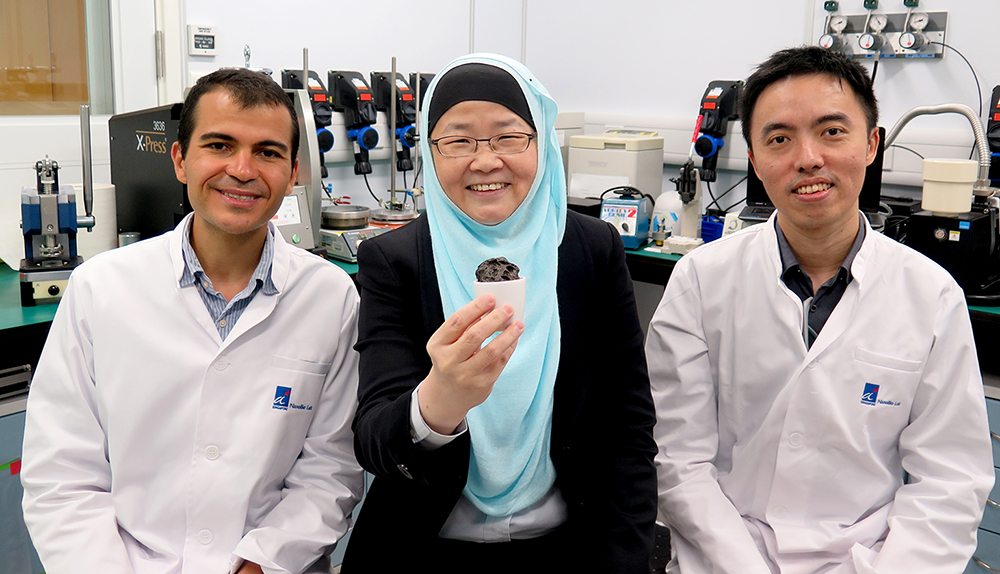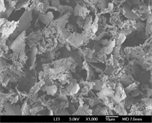A*STAR NEWS
Safer High-Performing Batteries with NanoBio Lab's 'Cupcake' Electrolyte
New innovative method improves safety in lithium-sulfur battery, and unlocks its potential for electronic and energy storage applications.

The NBL research team (left to right): Dr. Ayman AbdelHamid, Prof. Jackie Y. Ying and Mr. Jian Liang Cheong.
SINGAPORE – Researchers from A*STAR’s NanoBio Lab (NBL) have designed a semi-solid electrolyte for lithium-sulfur batteries that improves their safety without compromising their performance 1. This promising breakthrough paves the way for lithium-sulfur batteries to be used as efficient power solutions across diverse electronic and energy storage applications.
Safety is an important issue hindering the use of lithium batteries by industry, due to their highly flammable liquid organic electrolytes that leak easily, and their reliance on thermally and mechanically unstable electrode separators. While solid-state electrolytes have shown potential for improving the safety profile of lithium batteries, their poor electrode/electrolyte contact and limited ionic conductivity have resulted in major conductivity bottlenecks and low performance.
Prof. Jackie Y. Ying, who heads the NBL research team shared, “Hybrid quasi-solid electrolytes comprising both liquid and solid components have emerged as a practical compromise to obtain safer batteries while maintaining good performance. However, the high resistance of the solid component has thus far limited the performance of such batteries. To overcome this, we have reengineered the microstructure of the solid component. Our solution eliminates electrolyte leakage, and is thermally and mechanically stable.”
The NBL research team designed a hybrid quasi-solid electrolyte, which comprises a liquid-infused porous membrane made of Li7La3Zr2O12 (LLZO) sheets. The team also developed a novel method of fabricating the LLZO sheets used to construct the framework for the electrolyte. They named this one-step process for producing a 3D-sheet framework the ‘cupcake’ method.
LLZO was chosen for its high ionic conductivity, and good chemical and electrochemical stability. The electrolyte’s non-rigid structure allows it to maintain very good contact with electrodes and prevents it from cracking during handling and battery assembly. This results in safer batteries with better performance. NBL’s semi-solid electrolyte is also stable over a wide voltage range, allowing it to be used with different lithium battery electrode materials including high-voltage cathodes.
A lithium-sulfur battery made using NBL’s novel electrolyte showed high capacity, fast charge/discharge capability, and interesting polysulfide shuttling control 2 that stabilized the battery’s performance. In tests, the novel electrolyte achieved remarkable rate capability (~515 and ~340 mAh/g at 1 and 2C, respectively) at 1.5 mg/cm2 loading density. This is among the highest known performance achieved by lithium-sulfur hybrid quasi-solid batteries.
Prof. Ying said, “Our 3D sheet-based framework was found to be crucial for optimal battery performance. Moreover, our system demonstrated outstanding stability under extreme temperatures. These results illustrate the excellent potential of our sheet-based structure as a framework for other semi-solid lithium batteries.”
The NBL team is developing novel lithium-ion, lithium-sulfur and lithium solid-state batteries towards commercialization.

One-Step ‘Cupcake’ Synthesis Method
Metal precursors and sucrose are dissolved in water and placed in a pre-programmed furnace.
Inside the furnace:
- The solution is heated to form a brown ‘cupcake’.
- The ‘cupcake’ is then heated at high temperature to form sheets (image).
1 A. A. AbdelHamid, J. L. Cheong and J. Y. Ying, “Li7La3Zr2O12 Sheet-Based Framework for High-Performance Lithium-Sulfur Hybrid Quasi-Solid Battery,” Nano Energy, 71 (2020) 104633.
2 Polysulfide shuttling is a phenomenon typical for lithium-sulfur battery, whereby solubilized lithium polysulfides shuttle between both electrodes causing rapid capacity decay.
About NanoBio Lab
NanoBio Lab is a multidisciplinary lab-incubator that is committed to improving lives through scientific discovery and technological innovation. Using nanotechnology, we create new materials and systems with unique functions and enhanced properties for advanced applications. We work closely with hospitals and industry to shape the future of medicine, food safety, environmental monitoring and energy. Our research focus includes high-precision drug delivery vehicles, biocompatible materials for cell culture and medical use, portable detection kits for infectious diseases and food pathogens, intelligent sensors for environmental pollutants and food fraud, organs-on-chip for toxicology testing, advanced water purification membranes and innovative energy storage solutions. Our vision is to improve the world through nanotechnology. Under the direction of renowned nanotechnology researcher, Professor Jackie Y. Ying, the NanoBio Lab works at the intersection of chemistry, materials science, engineering, and medicine to develop new nanocomposites, biomaterials, synthetic molecules, devices and biosystems to tackle major global challenges. As a nationally funded Laboratory, we contribute toward the growth of Singapore’s economy by nurturing research talents, creating portfolios of intellectual properties, and commercializing new technologies. For ongoing news, visit www.a-star.edu.sg/nbl.
About the Agency for Science, Technology and Research (A*STAR)
The Agency for Science, Technology and Research (A*STAR) is Singapore's lead public sector R&D agency, spearheading economic-oriented research to advance scientific discovery and develop innovative technology. Through open innovation, we collaborate with our partners in both the public and private sectors to benefit society.
As a Science and Technology Organisation, A*STAR bridges the gap between academia and industry. Our research creates economic growth and jobs for Singapore, and enhances lives by contributing to societal benefits such as improving outcomes in healthcare, urban living, and sustainability.
We play a key role in nurturing and developing a diversity of talent and leaders in our Agency and research entities, the wider research community and industry. A*STAR’s R&D activities span biomedical sciences and physical sciences and engineering,
with research entities primarily located in Biopolis and Fusionopolis.
For ongoing news, visit www.a-star.edu.sg.
Was This Article Helpful ?
A*STAR celebrates International Women's Day

From groundbreaking discoveries to cutting-edge research, our researchers are empowering the next generation of female science, technology, engineering and mathematics (STEM) leaders.
Get inspired by our #WomeninSTEM
